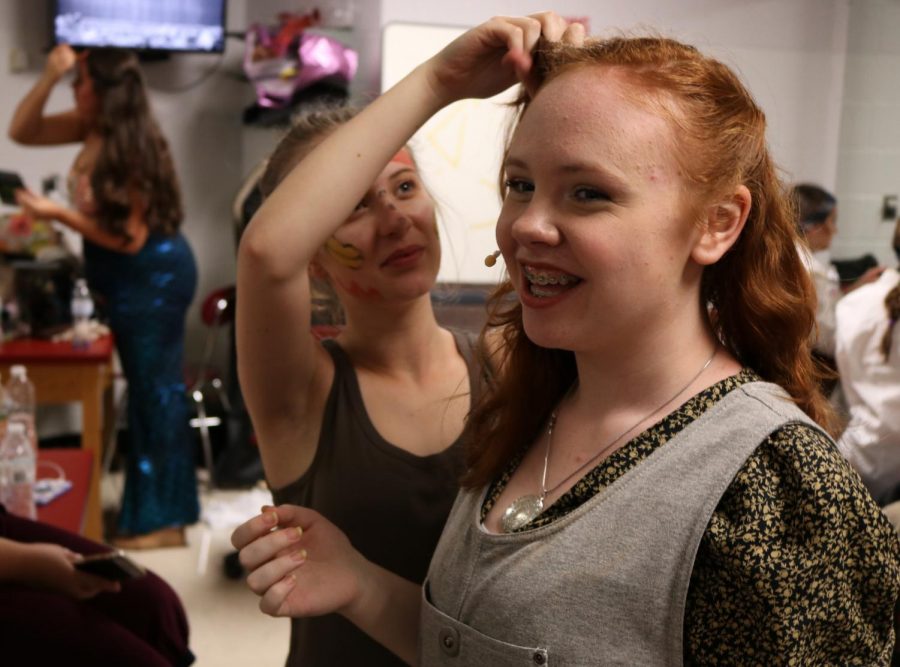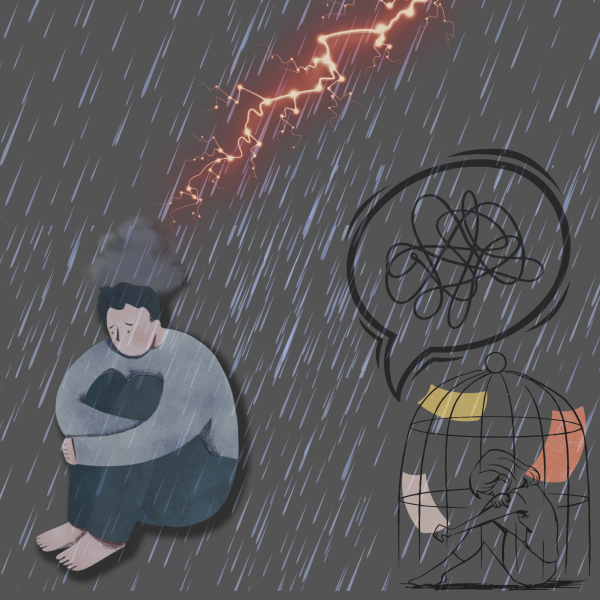Starstuff creates magic on stage
Eastern theatre performed its annual Fall play, Peter and the Starcatcher, from November 2nd to 4th.
Peter and the Starcatcher is a background story of “Peter Pan.” Peter in the story is known for being the boy that never grows up, living in Nevereverland with the Lost Boys. But how did he become that figure?
Peter Pan was an orphan that never met his family. He and two other orphan boys were put on the Neverland ship to be sent by Slank, the captain, to the island of Rundoon to become snake food. On this ship, they meet Molly, a starcatcher in training. She realizes that the valuable trunk of starstuff —bits of star that fall to earth—was switched from her father’s ship to hers. Molly takes on the mission, with the help of the boys, so the trunk can be safely transported to the Queen and not fall into the wrong hands.
Dr. Molotsky, a physics and environmental science teacher, is the head of the theatre department. Every year around fall time, he sits down with a bunch of plays trying to see which one he likes the best. “We were looking for a play that appeals to both kids and adults,” said Dr. Molotsky.
Along with picking a play that would put on a good show, he also picks out a cast that can execute it well. The students involved with the theatre program have been working with Molotsky for a while, but every year during casting they give something new. “Every year I ask myself ‘do we have students that can play these roles?’ I let the audience determine where the students fit best,” said Dr. Molotsky.
One character that gave the audience many laughs was Black Stache, played by senior Robert Sundstrom. “It [Black Stache] was an incredibly fun role to play because I was able to take a lot of liberties with the role.”
Kayla Kantakusin, a senior, was also excited for her role in Peter and Starcatcher. “In this year’s fall play, I played both a mermaid and a sailor. It was a lot of fun because I got to not only sing, but learn choreography as a mermaid.”
The cast and crew for the fall play only have six weeks to prepare while the spring musical usually has ten weeks. With a shorter time-frame the actors have more responsibility to make sure they are well prepared for opening night. Robert, however, likes to keep the same approach all year round. “I like to create a full character, so that anytime I’m on stage, I become that person instead of pretending to be that person,” said Robert.
Another difference between the fall play and the Spring musical is the sense of community, for the fall play gives off a more welcoming feel for newcomers. “The fall play usually harnesses a more family-like environment compared to the sometimes heavily-competitive vibes of the musical,” said Kayla Kantakusin.
Additionally, the Fall play focuses more on storyline along with diction and acting technique, while the spring musical is heavily focused on music.
Other than the actors and the director that keep the play running, stage crew plays a huge role. They are responsible for creating sets, changing the sets, the color theme, and lighting and sound.
The stage crew advisor is Mr. Isshak, a world history teacher. His role is to supply the students in stage crew with the equipment they need and also to be the overseer. “I make sure the students have the tools to get their job done, and to have a safe and productive meeting,” said Mr. Isshak.
Over the last few years, stage crew has become more student-centered, unlike before, where the stage crew advisors would come up with set design, the color theme, and how the set would function. Now the students have essentially taken over those roles. “We trusted these guys [the students] to start taking over our roles; they would design all of it, and they would really do the entire show,” said Mr. Isshak.
This is where stage crew leaders like seniors Chris Childs and Cyrena Kokolis come along. Chris and Cyrena are productive managers for both the Fall play and the Spring musical. They come up with tasks that needs to be done, and the other members in stage crew takes on those tasks.
Coming up with the design is a huge task for stage crew. They usually read the script, and the stage crew is instructed to come up with designs for different parts of the show. Afterwards, they all sit together and discuss it at a production meeting. “At the production meetings, it’s ‘what we need to get done what week’ because Mo (Dr. Motosky) needs certain things done at rehearsal,” said Chris.
Cyrena, along with being one of the production managers, is also paint charge. With paint guard, she picks out the color scheme and comes up the artistic side with the design. Junior Gabby Kuper is the assistant of the paint charge. “I am right now learning all ways we add color to the show,” said Gabby. As Cyrena is a senior and Gabby a junior, Gabby hopes to take over the paint charge job next year.
Senior Jannette Fisher was in charge of costumes and make up for this year’s fall pay. Although usually on the stage, she decided that she wanted to design all of the costumes this time. “Fashion design has always been a dream of mine, so being able to combine my dreams of fashion and theatre had a huge appeal to me,” said Jannette. She was able to come up with elaborate designs for the mermaids, mollusks, and the sailors.
Peter and the Starcatcher was a hilarious show that was also able to draw out true emotions. Like Molly the Starcatcher said, “It’s supposed to hurt, that’s how you know it meant something.”











